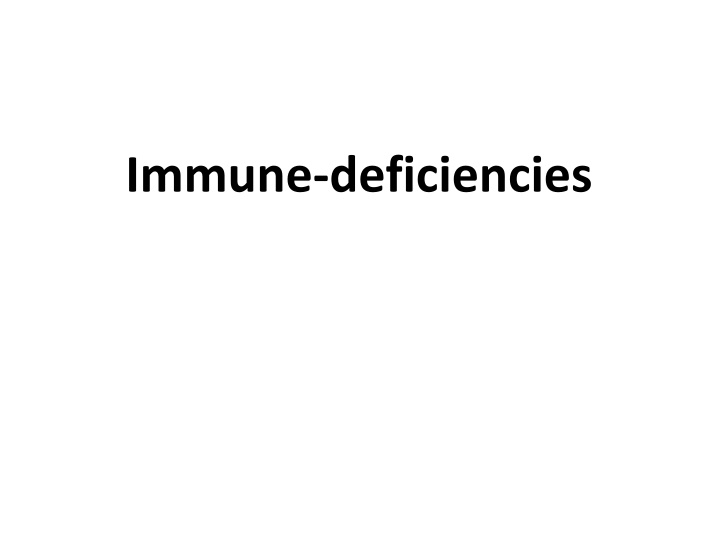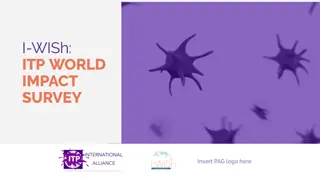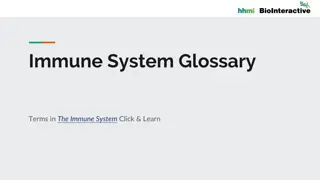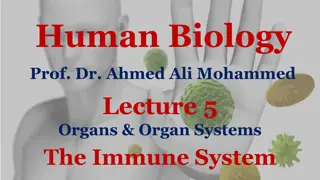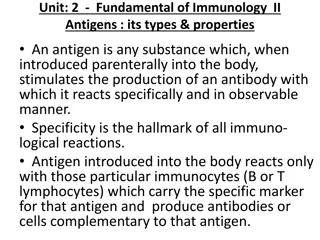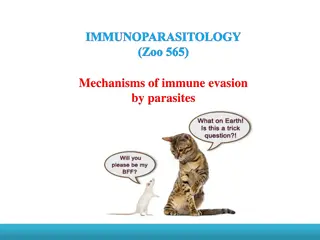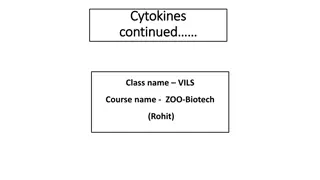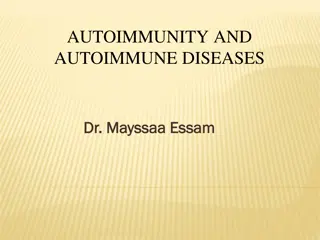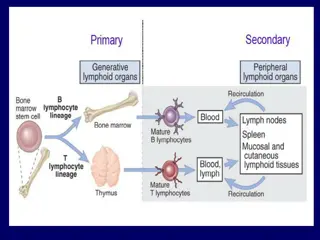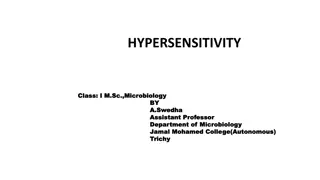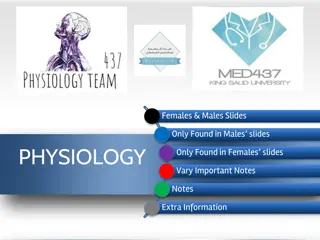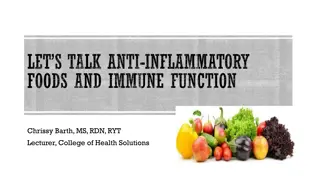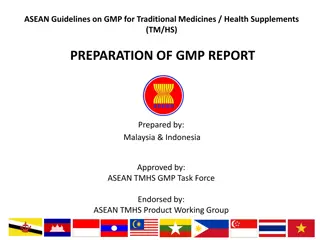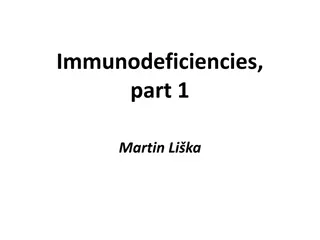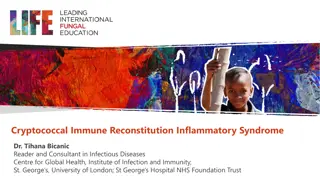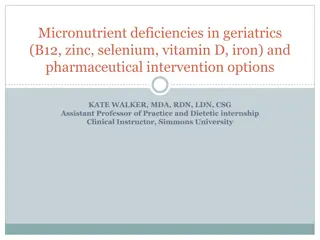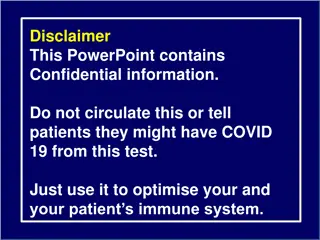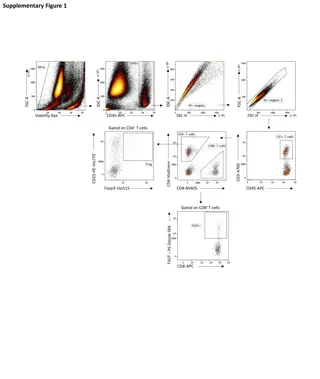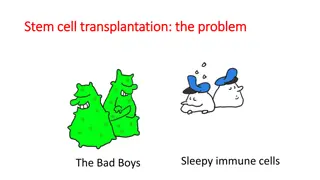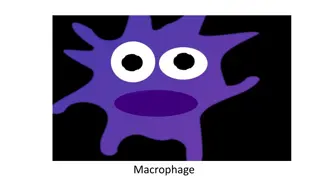Immune-deficiencies
Immune deficiencies can be classified into primary hereditary disorders based on clinical presentations, including cell-mediated, antibody-mediated, non-specific, and complement activation deficiencies. Major clinical manifestations of immune disorders range from B-cell deficiencies to phagocytic cell deficiencies, resulting in increased susceptibility to various infections. Severe Combined Immunodeficiency Disease (SCID) is a life-threatening condition characterized by infections soon after birth and a lack of lymphocyte responses to antigens. Primary immunodeficiencies such as X-linked SCID and adenosine deaminase deficiency further exemplify the complexity and severity of these disorders.
Download Presentation

Please find below an Image/Link to download the presentation.
The content on the website is provided AS IS for your information and personal use only. It may not be sold, licensed, or shared on other websites without obtaining consent from the author.If you encounter any issues during the download, it is possible that the publisher has removed the file from their server.
You are allowed to download the files provided on this website for personal or commercial use, subject to the condition that they are used lawfully. All files are the property of their respective owners.
The content on the website is provided AS IS for your information and personal use only. It may not be sold, licensed, or shared on other websites without obtaining consent from the author.
E N D
Presentation Transcript
Immune deficiencies Primary Hereditary Can be categorized based on clinical presentation Cell mediated (T cell) Antibody mediated (B cell) Non specific (phagocytes, NK cells) Complement activation
Major clinical manifestations of immune disorders Disorder Associated Disease Deficiency B cell deficiency deficiency in Ab mediated immunity T Lymphocyte deficiency deficiency in cell mediated immunity T and B lymphocyte deficiency combined deficiency of Ab- and cell- mediated immunity Phagocytic cell deficiency Recurrent bacterial disease (otitis media, recurrent pneumonia) Increased susceptibility to viral, fungal,protozoal infection Acute and chronic infections with viral, bacterial, fungal, and protozoal organisms Systemic infections with bacteria of usually low virulence, infections with pyogenic bacteria, impaired pus formation and would healing Viral infections, associated with several T cell disorders and X-linked lymphoproliferative syndromes Bacterial infections; autoimmunity NK cell deficiency Complement component deficiency
Severe Combined Immunodeficiency Disease (SCID) Life threatening infections soon after birth Lack of Thymic shadow Lack of CD3+, CD4+, CD8+ and lymphocyte response to antigens (also B-cell response)
Primary immunodeficiencies Severe Combined Immunodeficiency Disease T- B+ X-linked SCID (40-50% of cases) Lack g chain (CD25) for common cytokine receptor Autosomal recessive SCID Mutation in gene that encodes JAK3 tyrosine kinase
Primary immunodeficiency Severe Combined Immunodeficiency Disease T- B- Adenosine deaminase deficiency (20% of cases) Missing housekeeping enzyme in purine salvage pathway, autosomal recessive, buildup of toxic wastes affects B and T cells Purine nucleoside phosphorylase deficiency Purine salvage pathway, toxic wastes affect neurologic system and T cells (these patients have autoimmunity?!) Recombinase deficiency RAG 1 and 2 required for the rearrangement of Ig genes and TCR. Cells are stuck in pre-B and pre-T stages. NK cell function OK
Primary Immunodeficiency Severe Combined Immunodeficiency Disease T+ B- Omenn syndrome leaky SCID with partial RAG activity. Th2 imbalance and a tendency towards hyper IgE syndrome T+ B+ Bare lymphocyte syndrome Failure to express HLA molecules ZAP-70 mutation Unable to signal through TCR and BCR
Management of SCID patients Bone marrow/ stem cell transplant IV Ig if necessary Supportive care Avoid live viral vaccines! Gene therapy, if possible
Other immunodeficiencies of T cells and cell -mediated immunity
Other immunodeficiencies of T cells and cell -mediated immunity Patients are susceptible to viral, fungal, and protozoal infections Often exhibit selective defects in Ab production Can be difficult to distinguish from SCID patients
T cell deficiencies with normal peripheral T cell numbers Functional, rather than numerical defect in T cell population Susceptible to opportunistic infections, high incidence of autoimmune disease Autosomal recessive Deficient expression in: ZAP-70 tyrosine kinase (phenotype includes CD8 deficiency and SCID-like symptoms CD3e CD3g
Autoimmune LymphoProliferative Syndrome (ALPS) Systemic autoimmune disease, susceptible only to chronic viral infections Increased CD4-/CD8- T cells, can develop B cell lymphomas Most patients have a mutation in gene encoding for Fas (CD95)
B cell or Ig-associated Immunodeficiency May be associated with defective B cell development (absence of all Ig subclasses) or deficiency in subclass or class of Ig Patients suffer from recurrent or chronic infections
Bruntons agammaglobulinemia X-linked infantile agmmaglobulinemia 1:100,000 Noticed in infants at 5-6 months of age Serious and repeated bacterial infections Defect in BTK gene Pre-B cells cannot develop into mature B cells Treatment consists of IvIg injections, but chronic lung disease is a problem
Phagocytic dysfunctions Affect the innate and acquired response to pathogens Dysfunction in: Action required to phagocytize Migration and adhesion of phagocytic cells
Leukocyte adhesion deficiency (LAD) Autosomal recessive Group of disorders in which the leukocyte interaction with vascular endothelium is disrupted b subunit of integrins Selectin ligands Consequences: Recurrent soft tissue bacterial infection Increased blood WBC counts No pus formation or effective wound healing
Chronic Granulomatous Disease X-linked, autosomal recessive Skin, lymph node, lung infections High WBC in blood Phagocytes unable to complete respiratory burst Treatments include antibiotics, antifungals, IFNg
Complement Abnormalities Deficiencies inherited in autosomal fashion, heterozygotes have 50% of given complement protein Complement is required for: Opsonization and killing of bacteria Chemotaxis B cell activation Elimination of Ag-Ab complexes
INCIDENCE OF COMPLEMENT DEFICIENCIES IN NORMAL POPULATION POPULATION SWISS BRITISH JAPANESE N OF SUBJECTS EXAMINATED 40,000 2,000 145,640 N OF SUBJECTS WITH C DEFICIENCY 14 1 154 DEFECTIVE COMPONENT C2, C4 C6 + C7 C5(2), C6(4), C7(6), C8(4), C9 (138) REFERENCE Hessing et al, 1964 Lachman et al, 1978 Fukumori et al 1989; Inai et al 1989
THE INHERITED DEFICIENCIES OF C COMPONENTS AND REGULATORS ARE RARE IN THE GENERAL POPULATION The estimated frequency is 0.03% (3 per 10,000)
MBL DEFICIENCY IS COMMON IN THE GENERAL POPULATION Estimated frequency is 5-10% (Asymptomatic)
Early complement protein deficiencies C1, C2, C4 or C3 deficiency Pyogenic infections Autoimmunity SLE very common
Late complement protein deficiencies C5 - C9 Prevents formation of membrane attack complex Gram negative bacterial infections
Immune deficiencies Primary Hereditary Can be categorized based on clinical presentation Cell mediated (T cell) Antibody mediated (B cell) Non specific (phagocytes, NK cells) Complement activation Secondary Immune deficiency is the result of another disease
Acquired Immunodeficiencies Secondary immune deficiencies that are the consequences of other diseases Viral Infection
Immuno-pathogenesis of HIV-Infection HIV infects and ultimately destroys CD4+ , CCR5+ or CXCR4+ T cells, monocytes, & dendritic cells. Primary HIV Infection: A vigorous immune response to HIV controls the primary infection (clonal Cytotoxic T cells, suppressive chemokines, poorly neutralizing antibody)
Immuno-pathogenesis of HIV-Infection (continued) Chronic Asymptomatic Phase: Viral trapping & replication in lymphoid tissues, high rate turnover of virus and CD4 T cells, loss of CD4 functional help to CTL and antibody responses, destruction of lymph tissue, viral mutation and escape from recognition, exhaustion or viral inhibition of CD4 T cell renewal.
Immunopathogenesis of HIV-Infection (continued) Overt AIDS: CD4 count declines, viral load increases, opportunistic infections.
Acquired Immunodeficiencies Secondary immune deficiencies that are the consequences of other diseases Viral Infections Chemotherapeutic agents
IMMUNODEFICIENCY CAUSED BY DRUGS CORTICOSTEROIDS Inhibit cytokine synthesis Cause changes in circulating leukocytes Depletion of CD4 cells Monocytopenia Decreased in circulating eosinophils and basophils Inhibition of T cell activation and B cell maturation
IMMUNODEFICIENCY CAUSED BY DRUGS METHOTREXATE Structural analogue of folic acid Blocks folic acid dependent-synthetic pathways essential for DNA synthesis Prolonged use for treatment reduces immunoglobulin synthesis
IMMUNODEFICIENCY CAUSED BY DRUGS CYCOLOSPORIN Inhibit IL 2 dependent signal transduction blocking calcineurin Have severe effects on T cell signaling and functions
Acquired Immunodeficiencies Secondary immune deficiencies that are the consequences of other diseases Viral Infections Chemotherapeutic agents Malnutrition Untreated autoimmunity Overwhelming bacterial infection
Take Home Message Immunodeficiency may be congenital or acquired It can involve any component of the immune system such as cells, antibodies, complement etc. Most common presentation of immunodeficiency is recurrent infections that may be fatal due to delay in diagnosis and lack of appropriate therapy
Animal models in Immunology - Immunedeficency studies (genetic, acquired, temporary o induced) and its consequences Infective diseases Autoimmune diseases Cancer
Nude mice Topi Nudi: mutazione autosomica recessiva del locus nu sul cromosama 11. Porta ad aplasia timica (detti topi atimici), perdita di pelo (topi nudi). Mancanza di cellule T attive ma presenza di normali cellule B, NK, macrofagi, granulociti e complemento.
SCID mice SCID: Severe combined immunodeficiency Topi SCID: Ceppo di topi derivante dai C57/Bl privi totalmente di linfociti B e T per blocco precoce della maturazione linfocitaria dai precursori midollari. Tali topi presentano una mutazione a carico di un componente di un enzima (protein kinasi DNA-dipendente) necessario per la riparazione delle rotture del DNA a doppia elica. Il deficit enzimatico comporta alterazioni nelle giunzioni dei segmenti genici del TCR e delle Ig nel corso della ricombinazione dei geni dei recettori antigenici; ne consegue impossibilit di proseguire la maturazione da parte dei linfociti T e B per la mancata espressione di TCR e BCR. Rimane immutata l immunit innata.
NOD mice NOD: Diabetici non obesi. Topi mostrano una suscettibilit allo sviluppo della forma spontanea autoimmune di diabete mellito insulino- dipendente (IDDM). Topi NOD: Topi NOD possiedono polimorfismi nel locus Idd3 che collegato a IL-2. IL-2 promuove o l'immunit o la tolleranza in un modo dipendente dalla concentrazione, agendo sulle cellule helper T, cellule NK e CTL. Basse quantit di IL-2 sono necessari per promuovere la sopravvivenza dei Treg nei topi. Perdita di IL-2 pu quindi contribuire allo sviluppo di autoimmunit nei topi NOD. Incrociati per ottenere topi NOD-SCID
NSG mice NSG: NOD SCID Gamma Topi NSG: The NOD.Cg-Prkdcscid Il2rgtm1Wjl/SzJ mice, commonly known as NOD SCID Gamma (NSG), are severely immunocompromised, featuring absence of mature T or B cells, lack of functional NK cells and deficiency in cytokine signaling. The strain combines the features of the NOD/ShiLtJ background, the severe combined immune deficiency mutation (scid, which is caused by a spontaneous mutation in the Prkdc gene), and IL2 receptor gamma chain deficiency. Defect in C5 was also described. As a result, engraftment of human hematopoietic stem cells and peripheral- blood mononuclear cells in the NSG mice is greater than that in any other mouse strain.
Applications of immune-deficient mice 1. human tissue implantation
Applications of immune-deficient mice 2. implantation of non-murine cells in mice transplantation of human hematopoietic stem cells human cancer models in mice
